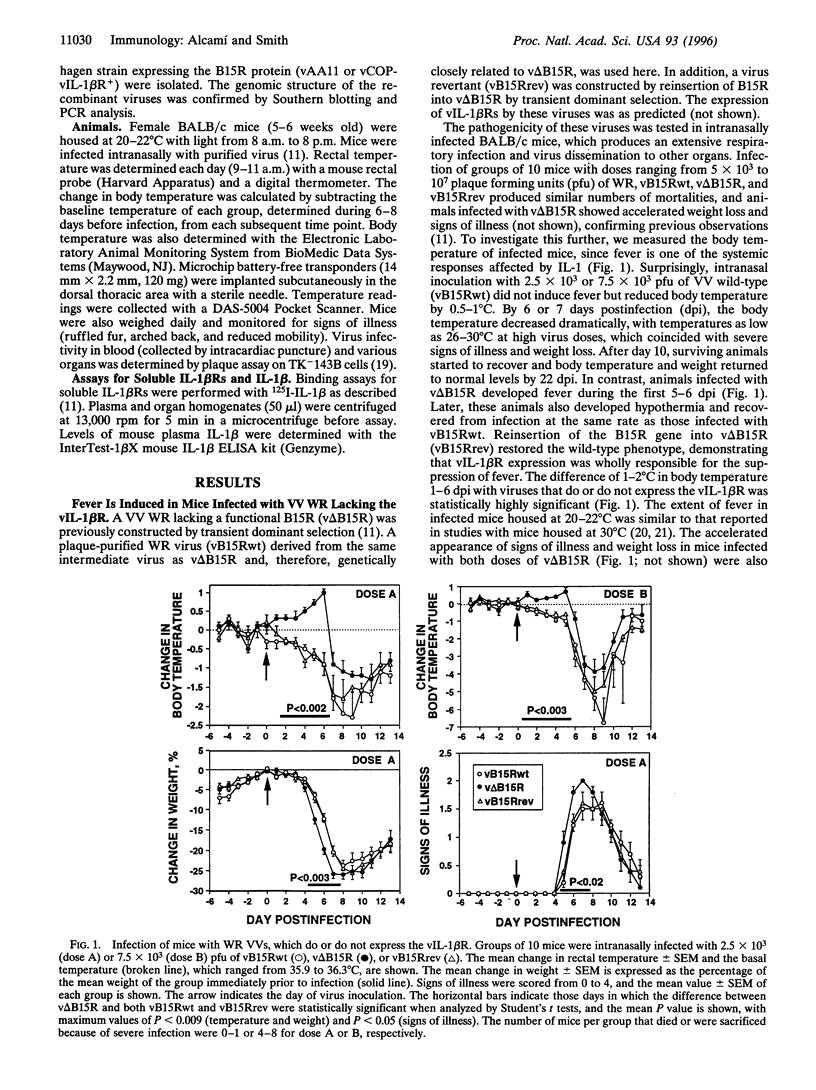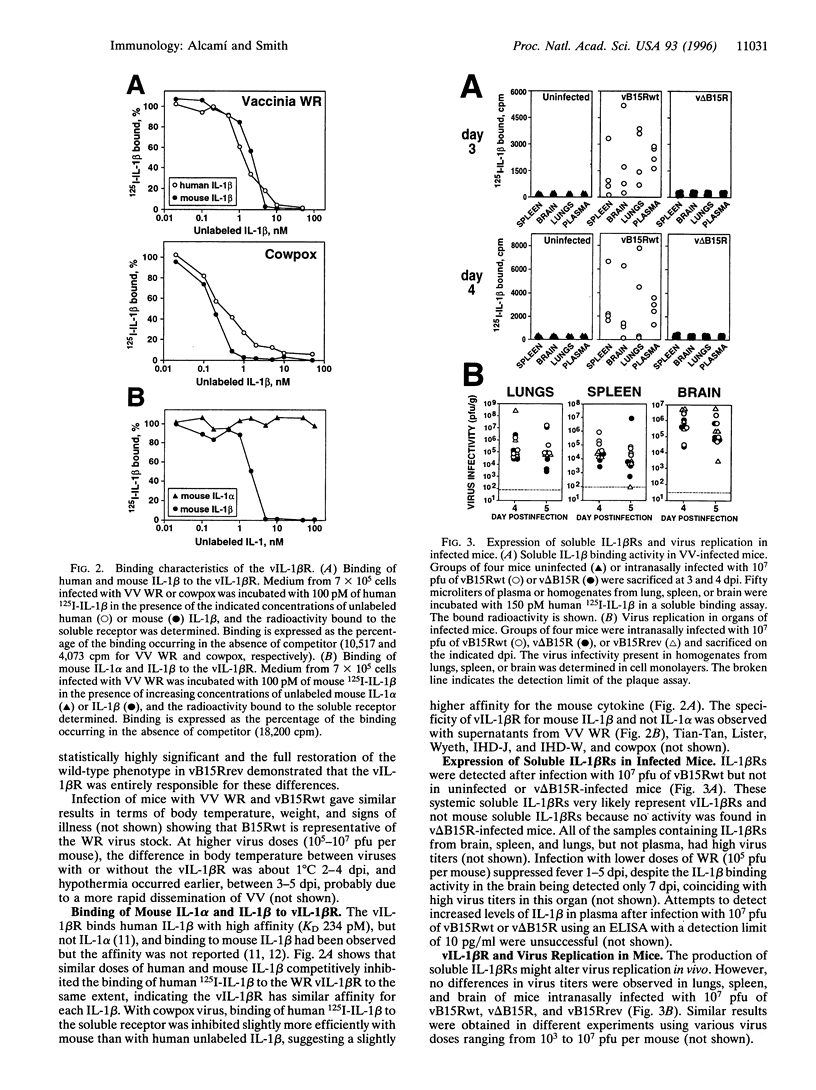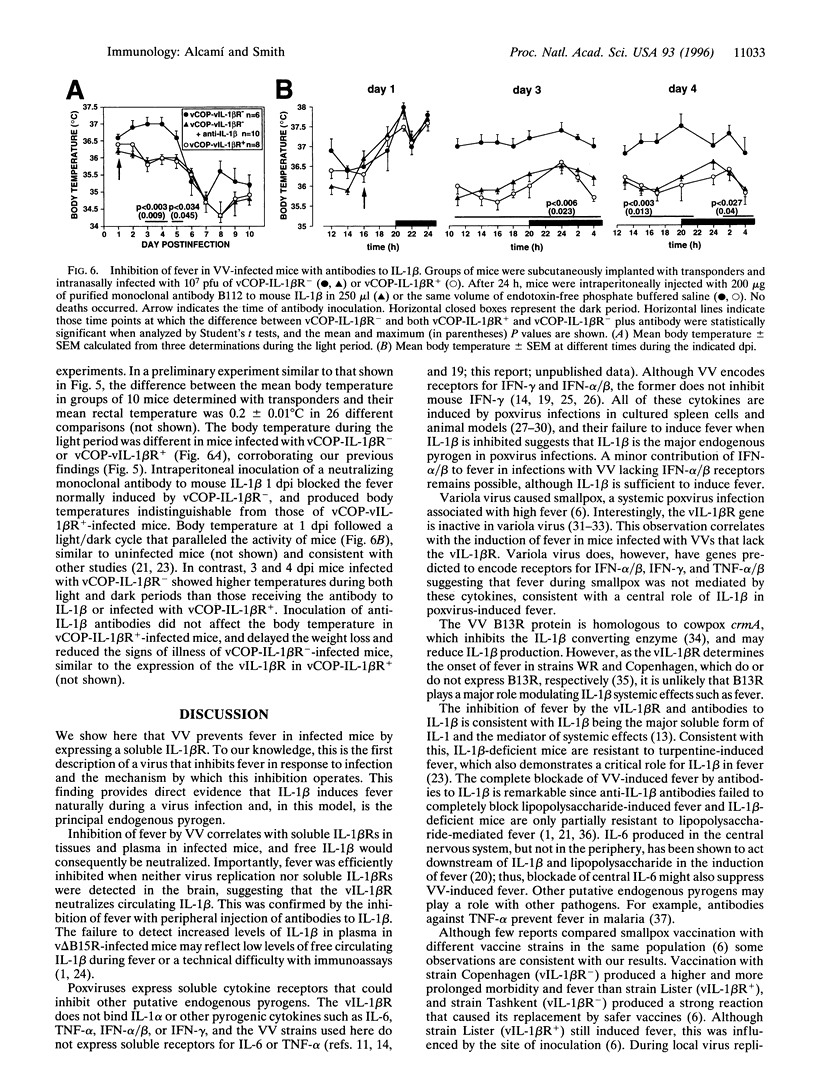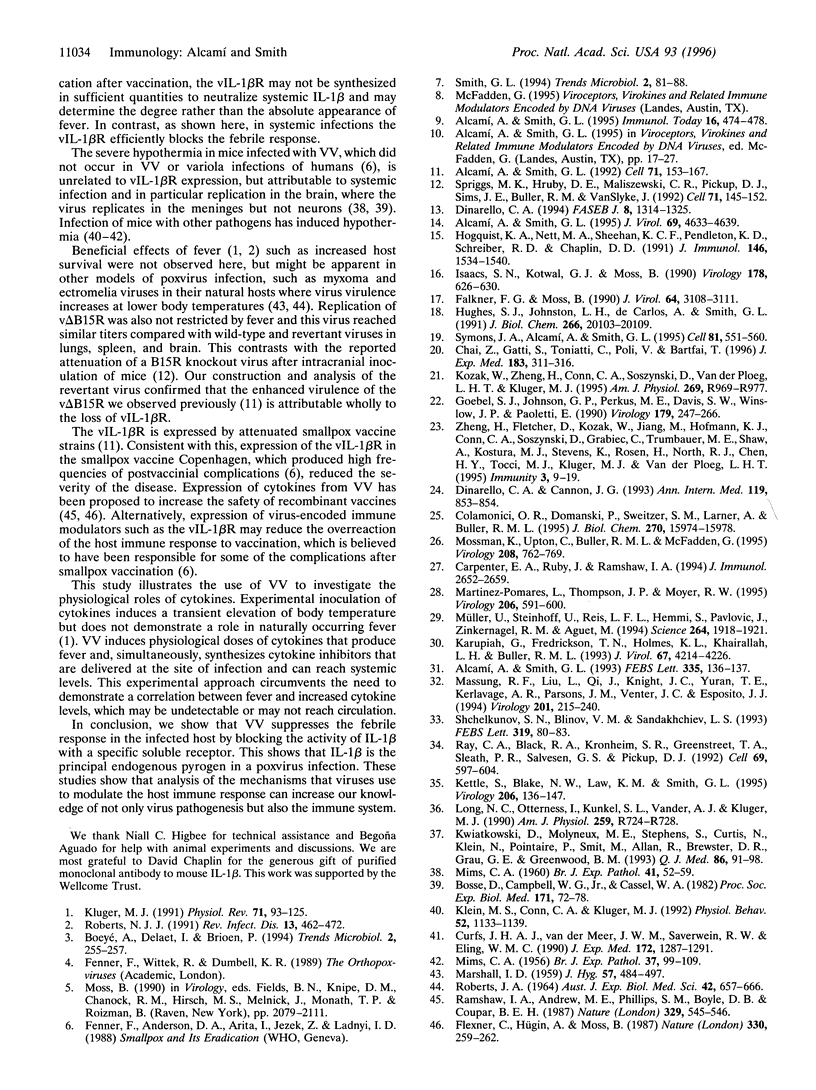Abstract
Poxviruses encode proteins that block the activity of cytokines. Here we show that the study of such virulence factors can contribute to our understanding of not only virus pathogenesis but also the physiological role of cytokines. Fever is a nonspecific response to infection that contributes to host defense. Several cytokines induce an elevation of body temperature when injected into animals, but in naturally occurring fever it has been difficult to show that any cytokine has a critical role. We describe the first example of the suppression of fever by a virus and the molecular mechanism leading to it. Several vaccinia virus strains including smallpox vaccines express soluble interleukin 1 (IL-1) receptors, which bind IL-1 beta but not IL-1 alpha. These viruses prevent the febrile response in infected mice, whereas strains that naturally or through genetic engineering lack the receptor induce fever. Repair of the defective IL-1 beta inhibitor in the smallpox vaccine Copenhagen, a more virulent virus than the widely used vaccine strains Wyeth and Lister, suppresses fever and attenuates the disease. The vaccinia-induced fever was inhibited with antibodies to IL-1 beta. These findings provide strong evidence that IL-1 beta, and not other cytokines, is the major endogenous pyrogen in a poxvirus infection.
Full text
PDF





Selected References
These references are in PubMed. This may not be the complete list of references from this article.
- Alcamí A., Smith G. L. A soluble receptor for interleukin-1 beta encoded by vaccinia virus: a novel mechanism of virus modulation of the host response to infection. Cell. 1992 Oct 2;71(1):153–167. doi: 10.1016/0092-8674(92)90274-g. [DOI] [PubMed] [Google Scholar]
- Alcamí A., Smith G. L. Comment on the paper by Shchelkunov et al. (1993) FEBS Letters 319, 80-83. Two genes encoding poxvirus cytokine receptors are disrupted or deleted in variola virus. FEBS Lett. 1993 Nov 29;335(1):136–138. doi: 10.1016/0014-5793(93)80455-4. [DOI] [PubMed] [Google Scholar]
- Alcamí A., Smith G. L. Cytokine receptors encoded by poxviruses: a lesson in cytokine biology. Immunol Today. 1995 Oct;16(10):474–478. doi: 10.1016/0167-5699(95)80030-1. [DOI] [PubMed] [Google Scholar]
- Alcamí A., Smith G. L. Vaccinia, cowpox, and camelpox viruses encode soluble gamma interferon receptors with novel broad species specificity. J Virol. 1995 Aug;69(8):4633–4639. doi: 10.1128/jvi.69.8.4633-4639.1995. [DOI] [PMC free article] [PubMed] [Google Scholar]
- Boeyé A., Delaet I., Brioen P. Antibody neutralization of picornaviruses: can fever help? Trends Microbiol. 1994 Jul;2(7):255–257. doi: 10.1016/0966-842x(94)90631-9. [DOI] [PubMed] [Google Scholar]
- Bosse D. C., Campbell W. G., Jr, Cassel W. A. Light and electron microscopic studies of the pathogenesis of vaccinia virus infection in mouse brain. Proc Soc Exp Biol Med. 1982 Oct;171(1):72–78. doi: 10.3181/00379727-171-41479. [DOI] [PubMed] [Google Scholar]
- Carpenter E. A., Ruby J., Ramshaw I. A. IFN-gamma, TNF, and IL-6 production by vaccinia virus immune spleen cells. An in vitro study. J Immunol. 1994 Mar 15;152(6):2652–2659. [PubMed] [Google Scholar]
- Chai Z., Gatti S., Toniatti C., Poli V., Bartfai T. Interleukin (IL)-6 gene expression in the central nervous system is necessary for fever response to lipopolysaccharide or IL-1 beta: a study on IL-6-deficient mice. J Exp Med. 1996 Jan 1;183(1):311–316. doi: 10.1084/jem.183.1.311. [DOI] [PMC free article] [PubMed] [Google Scholar]
- Colamonici O. R., Domanski P., Sweitzer S. M., Larner A., Buller R. M. Vaccinia virus B18R gene encodes a type I interferon-binding protein that blocks interferon alpha transmembrane signaling. J Biol Chem. 1995 Jul 7;270(27):15974–15978. doi: 10.1074/jbc.270.27.15974. [DOI] [PubMed] [Google Scholar]
- Curfs J. H., van der Meer J. W., Sauerwein R. W., Eling W. M. Low dosages of interleukin 1 protect mice against lethal cerebral malaria. J Exp Med. 1990 Nov 1;172(5):1287–1291. doi: 10.1084/jem.172.5.1287. [DOI] [PMC free article] [PubMed] [Google Scholar]
- Dinarello C. A., Cannon J. G. Cytokine measurements in septic shock. Ann Intern Med. 1993 Oct 15;119(8):853–854. doi: 10.7326/0003-4819-119-8-199310150-00013. [DOI] [PubMed] [Google Scholar]
- Dinarello C. A. The interleukin-1 family: 10 years of discovery. FASEB J. 1994 Dec;8(15):1314–1325. [PubMed] [Google Scholar]
- Falkner F. G., Moss B. Transient dominant selection of recombinant vaccinia viruses. J Virol. 1990 Jun;64(6):3108–3111. doi: 10.1128/jvi.64.6.3108-3111.1990. [DOI] [PMC free article] [PubMed] [Google Scholar]
- Flexner C., Hügin A., Moss B. Prevention of vaccinia virus infection in immunodeficient mice by vector-directed IL-2 expression. Nature. 1987 Nov 19;330(6145):259–262. doi: 10.1038/330259a0. [DOI] [PubMed] [Google Scholar]
- Goebel S. J., Johnson G. P., Perkus M. E., Davis S. W., Winslow J. P., Paoletti E. The complete DNA sequence of vaccinia virus. Virology. 1990 Nov;179(1):247-66, 517-63. doi: 10.1016/0042-6822(90)90294-2. [DOI] [PubMed] [Google Scholar]
- Hogquist K. A., Nett M. A., Sheehan K. C., Pendleton K. D., Schreiber R. D., Chaplin D. D. Generation of monoclonal antibodies to murine IL-1 beta and demonstration of IL-1 in vivo. J Immunol. 1991 Mar 1;146(5):1534–1540. [PubMed] [Google Scholar]
- Hughes S. J., Johnston L. H., de Carlos A., Smith G. L. Vaccinia virus encodes an active thymidylate kinase that complements a cdc8 mutant of Saccharomyces cerevisiae. J Biol Chem. 1991 Oct 25;266(30):20103–20109. [PubMed] [Google Scholar]
- Isaacs S. N., Kotwal G. J., Moss B. Reverse guanine phosphoribosyltransferase selection of recombinant vaccinia viruses. Virology. 1990 Oct;178(2):626–630. doi: 10.1016/0042-6822(90)90367-z. [DOI] [PubMed] [Google Scholar]
- Karupiah G., Fredrickson T. N., Holmes K. L., Khairallah L. H., Buller R. M. Importance of interferons in recovery from mousepox. J Virol. 1993 Jul;67(7):4214–4226. doi: 10.1128/jvi.67.7.4214-4226.1993. [DOI] [PMC free article] [PubMed] [Google Scholar]
- Kettle S., Blake N. W., Law K. M., Smith G. L. Vaccinia virus serpins B13R (SPI-2) and B22R (SPI-1) encode M(r) 38.5 and 40K, intracellular polypeptides that do not affect virus virulence in a murine intranasal model. Virology. 1995 Jan 10;206(1):136–147. doi: 10.1016/s0042-6822(95)80028-x. [DOI] [PubMed] [Google Scholar]
- Klein M. S., Conn C. A., Kluger M. J. Behavioral thermoregulation in mice inoculated with influenza virus. Physiol Behav. 1992 Dec;52(6):1133–1139. doi: 10.1016/0031-9384(92)90472-e. [DOI] [PubMed] [Google Scholar]
- Kluger M. J. Fever: role of pyrogens and cryogens. Physiol Rev. 1991 Jan;71(1):93–127. doi: 10.1152/physrev.1991.71.1.93. [DOI] [PMC free article] [PubMed] [Google Scholar]
- Kozak W., Zheng H., Conn C. A., Soszynski D., van der Ploeg L. H., Kluger M. J. Thermal and behavioral effects of lipopolysaccharide and influenza in interleukin-1 beta-deficient mice. Am J Physiol. 1995 Nov;269(5 Pt 2):R969–R977. doi: 10.1152/ajpregu.1995.269.5.R969. [DOI] [PubMed] [Google Scholar]
- Kwiatkowski D., Molyneux M. E., Stephens S., Curtis N., Klein N., Pointaire P., Smit M., Allan R., Brewster D. R., Grau G. E. Anti-TNF therapy inhibits fever in cerebral malaria. Q J Med. 1993 Feb;86(2):91–98. [PubMed] [Google Scholar]
- Long N. C., Otterness I., Kunkel S. L., Vander A. J., Kluger M. J. Roles of interleukin 1 beta and tumor necrosis factor in lipopolysaccharide fever in rats. Am J Physiol. 1990 Oct;259(4 Pt 2):R724–R728. doi: 10.1152/ajpregu.1990.259.4.R724. [DOI] [PubMed] [Google Scholar]
- MARSHALL I. D. The influence of ambient temperature on the course of myxomatosis in rabbits. J Hyg (Lond) 1959 Dec;57:484–497. doi: 10.1017/s0022172400020325. [DOI] [PMC free article] [PubMed] [Google Scholar]
- MIMS C. A. Intracerebral injections and the growth of viruses in the mouse brain. Br J Exp Pathol. 1960 Feb;41:52–59. [PMC free article] [PubMed] [Google Scholar]
- MIMS C. A. Rift Valley Fever virus in mice. I. General features of the infection. Br J Exp Pathol. 1956 Apr;37(2):99–109. [PMC free article] [PubMed] [Google Scholar]
- Martinez-Pomares L., Thompson J. P., Moyer R. W. Mapping and investigation of the role in pathogenesis of the major unique secreted 35-kDa protein of rabbitpox virus. Virology. 1995 Jan 10;206(1):591–600. doi: 10.1016/s0042-6822(95)80076-x. [DOI] [PubMed] [Google Scholar]
- Massung R. F., Liu L. I., Qi J., Knight J. C., Yuran T. E., Kerlavage A. R., Parsons J. M., Venter J. C., Esposito J. J. Analysis of the complete genome of smallpox variola major virus strain Bangladesh-1975. Virology. 1994 Jun;201(2):215–240. doi: 10.1006/viro.1994.1288. [DOI] [PubMed] [Google Scholar]
- Mossman K., Upton C., Buller R. M., McFadden G. Species specificity of ectromelia virus and vaccinia virus interferon-gamma binding proteins. Virology. 1995 Apr 20;208(2):762–769. doi: 10.1006/viro.1995.1208. [DOI] [PubMed] [Google Scholar]
- Müller U., Steinhoff U., Reis L. F., Hemmi S., Pavlovic J., Zinkernagel R. M., Aguet M. Functional role of type I and type II interferons in antiviral defense. Science. 1994 Jun 24;264(5167):1918–1921. doi: 10.1126/science.8009221. [DOI] [PubMed] [Google Scholar]
- ROBERTS J. A. ENHANCEMENT OF THE VIRULENCE OF ATTENUATED ECTROMELIA VIRUS IN MICE MAINTAINED IN A COLD ENVIRONMENT. Aust J Exp Biol Med Sci. 1964 Dec;42:657–666. doi: 10.1038/icb.1964.63. [DOI] [PubMed] [Google Scholar]
- Ramshaw I. A., Andrew M. E., Phillips S. M., Boyle D. B., Coupar B. E. Recovery of immunodeficient mice from a vaccinia virus/IL-2 recombinant infection. Nature. 1987 Oct 8;329(6139):545–546. doi: 10.1038/329545a0. [DOI] [PubMed] [Google Scholar]
- Ray C. A., Black R. A., Kronheim S. R., Greenstreet T. A., Sleath P. R., Salvesen G. S., Pickup D. J. Viral inhibition of inflammation: cowpox virus encodes an inhibitor of the interleukin-1 beta converting enzyme. Cell. 1992 May 15;69(4):597–604. doi: 10.1016/0092-8674(92)90223-y. [DOI] [PubMed] [Google Scholar]
- Roberts N. J., Jr Impact of temperature elevation on immunologic defenses. Rev Infect Dis. 1991 May-Jun;13(3):462–472. doi: 10.1093/clinids/13.3.462. [DOI] [PubMed] [Google Scholar]
- Shchelkunov S. N., Blinov V. M., Sandakhchiev L. S. Genes of variola and vaccinia viruses necessary to overcome the host protective mechanisms. FEBS Lett. 1993 Mar 15;319(1-2):80–83. doi: 10.1016/0014-5793(93)80041-r. [DOI] [PubMed] [Google Scholar]
- Smith G. L. Virus strategies for evasion of the host response to infection. Trends Microbiol. 1994 Mar;2(3):81–88. doi: 10.1016/0966-842x(94)90539-8. [DOI] [PubMed] [Google Scholar]
- Spriggs M. K., Hruby D. E., Maliszewski C. R., Pickup D. J., Sims J. E., Buller R. M., VanSlyke J. Vaccinia and cowpox viruses encode a novel secreted interleukin-1-binding protein. Cell. 1992 Oct 2;71(1):145–152. doi: 10.1016/0092-8674(92)90273-f. [DOI] [PubMed] [Google Scholar]
- Symons J. A., Alcamí A., Smith G. L. Vaccinia virus encodes a soluble type I interferon receptor of novel structure and broad species specificity. Cell. 1995 May 19;81(4):551–560. doi: 10.1016/0092-8674(95)90076-4. [DOI] [PubMed] [Google Scholar]
- Zheng H., Fletcher D., Kozak W., Jiang M., Hofmann K. J., Conn C. A., Soszynski D., Grabiec C., Trumbauer M. E., Shaw A. Resistance to fever induction and impaired acute-phase response in interleukin-1 beta-deficient mice. Immunity. 1995 Jul;3(1):9–19. doi: 10.1016/1074-7613(95)90154-x. [DOI] [PubMed] [Google Scholar]


